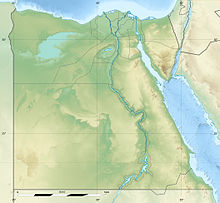- Thebes, Egypt
-
For the Greek city of Boeotia, see Thebes, Greece. For other cities called Thebes, see Thebes.
Ancient Thebes with its Necropolis * UNESCO World Heritage SiteCountry Egypt Type Cultural Criteria i, iii, vi Reference 87 Region ** Arab States Inscription history Inscription 1979 (3rd Session) * Name as inscribed on World Heritage List
** Region as classified by UNESCOThebes (Θῆβαι, Thēbai, Arabic: طيبة, Ṭībah) is the Greek name for a city in Ancient Egypt located about 800 km south of the Mediterranean, on the east bank of the river Nile within the modern city of Luxor. The Theban Necropolis is situated nearby on the west bank of the Nile.
Contents
History
 Lithic core: Museum of Toulouse
Lithic core: Museum of Toulouse
Thebes was inhabited from around 3200 BC.[1] It was the eponymous capital of Waset, the fourth Upper Egyptian nome. Waset was the capital of Egypt during part of the 11th Dynasty (Middle Kingdom) and most of the 18th Dynasty (New Kingdom), when Hatshepsut built a Red Sea fleet to facilitate trade between Thebes Red Sea port of Elim, modern Quasir, and Elat at the head of the Gulf of Aqaba. Traders bought frankincense, myrrh, bitumen, natron, fine woven linen, juniper oil and copper amulets for the mortuary industry at Karnak with Nubian gold. With the 19th Dynasty the seat of government moved to the Delta. The archaeological remains of Thebes offer a striking testimony to Egyptian civilization at its height. The Greek poet Homer extolled the wealth of Thebes in the Iliad, Book 9 (c. 8th Century BC): "... in Egyptian Thebes the heaps of precious ingots gleam, the hundred-gated Thebes."
The name Thebai is the Greek designation of the ancient Egyptian opet "The Karnak Temple" (from coptic ta-pe, Ta-opet became Thebai). At the seat of the Theban triad of Amun, Mut, and Khonsu, Thebes was known in the Egyptian language from the end of the New Kingdom as niwt-imn, "The City of Amun." This found its way into the Hebrew Bible as נא אמון (nōʼ ʼāmôn) (Nahum 3:8),"no" in Hebrew meaning city with "no amon" or "City of Amon" referring to the Egyptian deity Amon-Ra, most likely it is also the same as נא ("No") (Ezekiel 30:14). In Greek this name was rendered Διόσπολις Diospolis, "City of Zeus", as Zeus was the god whom the Greeks identified with Amun, see interpretatio graeca. The Greeks surnamed the city μεγάλη megale, "the Great", to differentiate it from numerous other cities called Diospolis. The Romans rendered the name Diospolis Magna.
In modern usage, the mortuary temples and tombs on the west bank of the river Nile are generally thought of as part of Thebes.
In 1979, the ruins of ancient Thebes were inscribed by UNESCO as a World Cultural Heritage site. The two great temples the Valley of the Kings and the Valley of the Queens, Luxor Temple (Arabic: الأقصر, Al-Uqṣur, "The palaces") and al-Karnak (الكرنك), are among the great achievements of ancient Egypt.
Names in hieroglyphs

w3s.t
City of the Sceptre[2]
in hieroglyphs
![X1 [t] t](/w/extensions/wikihiero/img/hiero_X1.png)
![O49 [niwt] niwt](/w/extensions/wikihiero/img/hiero_O49.png)
w3s.t
in hieroglyphs![O49 [niwt] niwt](/w/extensions/wikihiero/img/hiero_O49.png)
![X1 [t] t](/w/extensions/wikihiero/img/hiero_X1.png)


![X1 [t] t](/w/extensions/wikihiero/img/hiero_X1.png)
niw.t rs.t
Southern City[3]
in hieroglyphs
![W24 [nw] nw](/w/extensions/wikihiero/img/hiero_W24.png)
![O49 [niwt] niwt](/w/extensions/wikihiero/img/hiero_O49.png)
![M26 [Sma] Sma](/w/extensions/wikihiero/img/hiero_M26.png)
iwnw-sm’
Heliopolis of the South[4]
in hieroglyphsSee also
Notes
- ^ http://www.ancient-wisdom.co.uk/egyptkarnak.htm
- ^ Adolf Erman, Hermann Grapow: Wörterbuch der ägyptischer Sprache. akademie Verlag, Berlin, 1971. p.259
- ^ Wörterbuch, p.211
- ^ Wörterbuch, pp.54,479
References
- Gauthier, Henri. 1925–1931. Dictionnaire des noms géographiques contenus dans les textes hieroglyphiques. Vol. 3 of 7 vols. Cairo: Imprimerie de l’Institut français d’archéologie orientale du Caire. (Reprinted Osnabrück: Otto Zeller Verlag, 1975). 75, 76.
- Polz, Daniel C. 2001. "Thebes". In The Oxford Encyclopedia of ancient Egypt, edited by Donald Bruce Redford. Vol. 3 of 3 vols. Oxford, New York, and Cairo: Oxford University Press and The American University in Cairo Press. 384–388.
- Redford, Donald Bruce. 1992. "Thebes". In The Anchor Bible Dictionary, edited by David Noel Freedman. Vol. 6 of 6 vols. New York: Doubleday. 442–443. ISBN 0-385-42583-X (6-volume set)
- Strudwick, Nigel C., & Strudwick, Helen, Thebes in Egypt: A Guide to the Tombs and Temples of Ancient Luxor. London: British Museum Press, 1999, ISBN 0-8014-3693-1 (hardcover)/ISBN 0-8014-8616-5 (paperback)
External links
- More information on ancient Thebes, a World Cultural Heritage site
- Theban Mapping Project
- Ramesseum/Ancient Thebes Digital Media Archive (photos, laser scans, panoramas), data from an Egyptian Supreme Council of Antiquities/CyArk research partnership
- ICOMOS Heritage at Risk 2001/2002
Preceded by
HerakleopolisCapital of Egypt
2060 BC - 1785 BCSucceeded by
AvarisPreceded by
AvarisCapital of Egypt
1580 BC - c. 1353 BCSucceeded by
AkhetatenPreceded by
AkhetatenCapital of Egypt
c. 1332 BC - 1085 BCSucceeded by
TanisWorld Heritage Sites in Egypt Abu Mena · Islamic Cairo · Memphis and its Necropolis – the Pyramid Fields from Giza to Dahshur · Nubian Monuments from Abu Simbel to Philae · Saint Catherine Area · Ancient Thebes with its Necropolis · Wadi Al-Hitan (Whale Valley)
Ancient Egypt Outline · Index
Architecture · Art · Burial customs · Chronology · Cuisine · Dynasties · Geography · History · Literature · Mathematics · Medicine · Military · Music · Religion · Pharaohs (list) · People · Language · Sites · Technology · Writing
Egyptology · Egyptologists · Egyptian MuseumPortal · List of major topicsCoordinates: 25°43′14″N 32°36′37″E / 25.72056°N 32.61028°E
Categories:- World Heritage Sites in Egypt
- Archaeological sites in Egypt
- Cities in Ancient Egypt
- Former populated places in Egypt
Wikimedia Foundation. 2010.


